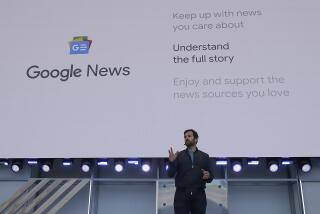On the Media: The price of ‘free’ journalism
- Share via
It’s been more than a quarter-century since futurist Stewart Brand said, “Information wants to be free.” In about half that time, the founders of Google have accumulated fabulous riches by putting free information a mouse click away. Six years on, Arianna Huffington has shown that free content, assembled by a couple hundred paid journalists and thousands of unpaid bloggers, can pay off in a big way — at least for her.
In recent days, the second part of Brand’s aphorism has also been proved. The technology enthusiast, who created the Whole Earth Catalog, also said, “Information wants to be expensive.” He predicted that the collision between the high cost of producing good information and the technology that enabled the cheap spread of that information would create “endless wrenching debate about price, copyright, ‘intellectual property,’ the moral rightness of casual distribution.”
Did it ever. Even as AOL’s Patch.com looks for 8,000 new bloggers to cover suburbia for free and a photo agency announces it will try to profit from images people freely post via Twitter, strong voices push in the other direction: One of America’s top sportswriters, Rick Reilly, urges journalism school grads to insist on being paid. A survey finds some of the most popular Huffington Post bloggers would (surprise!) like compensation. Prominent Silicon Valley entrepreneur Bill Davidow urges Google to find a way to get money back in the hands of writers to preserve “reliable news — a national treasure.”
Those morsels came floating over the Internet not long after a freelance writer and political gadfly, Jonathan Tasini, served up both a lawsuit and a boycott against Huffington Post, trying to get cash for himself and other writers who have posted on the site. The lawsuit, on behalf of writers who knowingly hopped on the freebie express, seems like a long shot. And the attempt to erect a virtual picket line around HuffPo has been “a little bit of a struggle,” Tasini told me.
But the financial disparity continues to cause friction in the world of content creators, the people we once knew as writers, photographers and editors.
“There has to be a concern if free journalistic labor becomes normal and normative in the profession,” Harold Meyerson, editor at large of the American Prospect and a columnist for the Washington Post said when I called him. “Eventually that would subvert newsgathering as we know it, and journalism itself.”
So what to do?
High-tech investor Davidow, a onetime executive at Intel, is just the latest figure weaned in the Silicon Valley to assess the Information Age’s collateral damage. His book “Overconnected” describes the Internet’s culpability in everything from invasions of privacy to the recent financial calamity.
Writing in the Christian Science Monitor this week, Davidow argued that the unfettered flow of information means businesses can “externalize costs” (i.e. get someone else to perform the expensive original labor) while making huge profits.
Davidow asked why Google shouldn’t also charge for its news aggregation service, then pass some of the revenue on to original content creators. That, he said, would support “high-quality news and investigative reporting that is the key to preserving our democracy.”
In another venue, its video-sharing site YouTube, Google has shown a willingness to spread the wealth.
The YouTube Partner Program has 20,000 participants in 21 countries, the company reports. The independent video-makers get more than half of the revenue from ads sold alongside their creations. A company spokeswoman says “hundreds” of partners earn six figures in revenue a year. “Thousands” of video partners make at least $1,000 a month. The company declined to be more specific.
Couldn’t that sort of pay-for-traffic system be extended to the top companies and individuals who attract eyeballs to Google and its ads? Maybe Huffington Post could reward its most productive bloggers with a cut of the revenue, as well.
A dollars-for-clicks system has its pitfalls. We know that the biggest payoffs would not always go to the best-reported, most-polished pieces. Not when they have to compete with Charlie Sheen’s latest rant or a titillating photo gallery. (Celebrity boob jobs, anyone?)
A system that is more stable, less vulnerable to market fluctuation, would be required to prop up long-term reporting and less frothy subject matter. That system used to be known as a salary. News outlets paid and took on the risk that not every story would pan out, or draw a maximum audience. But the best newspapers and TV networks plowed some of their revenue back into newsgathering, knowing it took more than the quick and dirty to burnish their brands.
Not that up-front money is the end-all for writers. Some benefit by having a big-audience platform like Huffington Post to disseminate their ideas, promote their causes or sell their books. In some instances, the attention can lead to a paying gig.
It’s just that those paying jobs are fewer and farther between. Freelance writing fees, for all but the highest- end magazines, have continued to spiral downward.
Academics at UC Santa Barbara said they recently contacted 60 of the most popular contributors at Huffington Post. They got responses from 26 of them, most of whom said they believed they should share in the $315 million AOL paid for the website. Good luck with that.
But the scribes also hope for something more modest — some kind of payment for their submissions. They said they might be willing to join a union to get a cut.
Michael Curtin, a professor of film and media studies who helped collect the information, said “sacrificial labor” has long been an issue in entertainment. Low-paid go-fers prop up many a multimillion-dollar film.
As news consumers become producers, the issue has leaped to journalism.
“In a more interactive media universe, there are wonderful opportunities but also opportunities for exploitation,” Curtin said. “It seems like it’s time to have the conversation about what we do about that.”
Twitter: latimesrainey
More to Read
The biggest entertainment stories
Get our big stories about Hollywood, film, television, music, arts, culture and more right in your inbox as soon as they publish.
You may occasionally receive promotional content from the Los Angeles Times.











